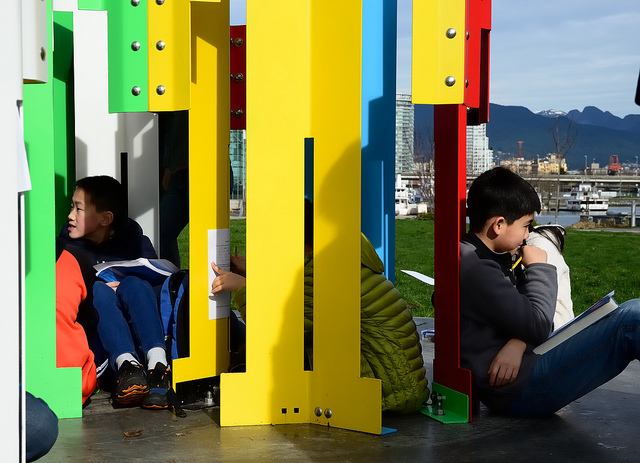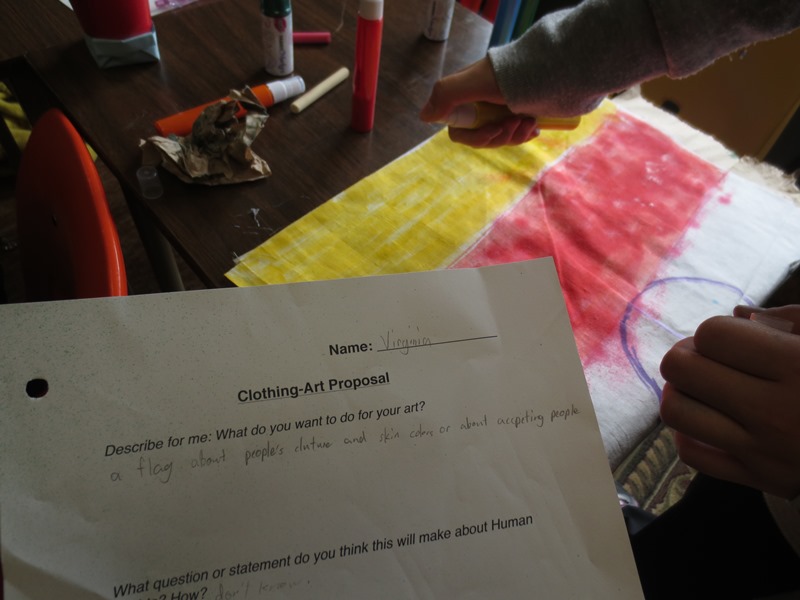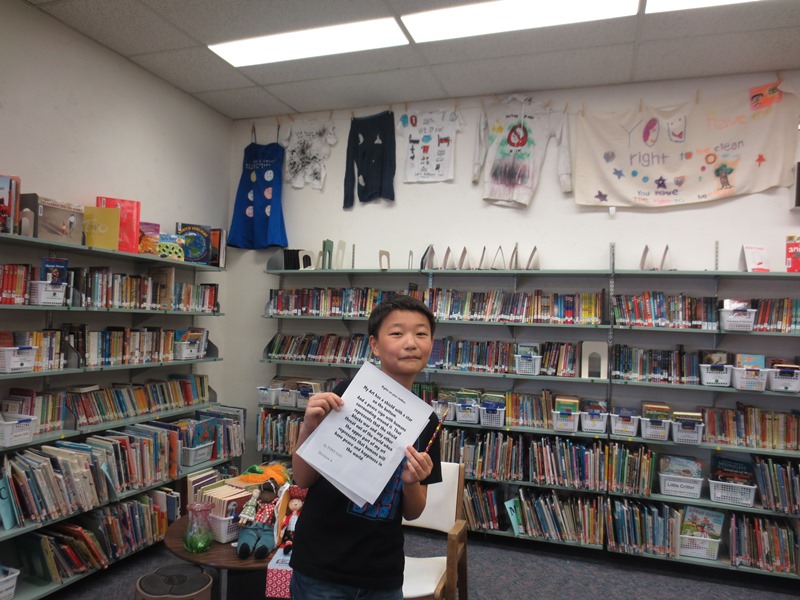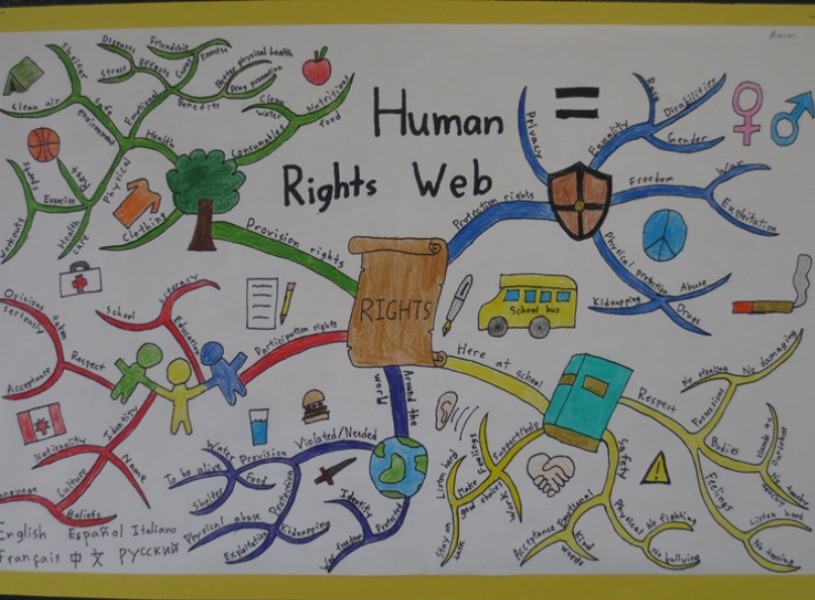McKinney Elementary: Visualizing Human Rights
Arts Education, Language Arts, Science
School: McKinney Elementary, Richmond
Teacher: Graham Essex
Artist Collaborators: Stephen Booth
Class: Grade 5/6
Overview
The students examined the topics of human rights through discussions of literature, expressed their thoughts in writing, performance pieces and culminate this inquiry through the creation of public art pieces. The project enabled students to express themselves in new and deeper ways, as well as to make the visual arts really come alive as a way students can convey meaning.
Connection to the Vancouver Biennale Exhibition
The class paid a visit to Human Structures Vancouver by Jonathan Borofsky and examined his statement on people around the world working to build the world, and whether that reflects his thoughts on how rights are protected in the world, or if this is more reflective of how they should be protected. Students also reflected and shared ideas about how they might display their ideas through art, whether through drawing, painting, or sculpture.
In examining the nature of how rights are protected, and how they should be protected, the students reflected upon their situation, and the situations of others, both in their community and around the world. In so doing, students became more aware of people of different nationalities, abilities, and economic status, helping to break down both international and social borders of class.
BIG IDEAS
Artwork has the power to reflect the levels of equality, fairness, and human rights found in the world today
Guiding Questions
• What are our most important rights?
• How should our rights be protected?
• How can we use visual art to share our beliefs about human rights?
Cross-Curricular Access
• Arts Education: students created a collaborative artwork to express the fundamental rights and responsibilities of all global citizens. The students created a mixed media clothing-art exhibit using a variety of materials for permanent exhibit at the school library.
• Language Arts: students read a collection of texts where the rights of the characters are under-protected or protected in a questionable way. Using these examples, students questioned the way that human rights should be ensured for all. Further, students undergo a study of poetry, to examine the way in which the written word can express similar ideas to that expressed through visual art.
• Science – the Human Body: students investigated the effects on the different systems of the Human body when particular rights are not protected (for instance, the rights to good food, shelter, healthcare). Students expressed these rights visually in a Human Rights Web and reflected upon the importance of those rights, and created an action plan to ensure those needs are met for all in the community.
Learning Process/Inquiry Challenges
• What are human rights? Students read the UN Declaration on the Rights of the Child, and will reflect upon how those rights are met in their own life.
• How are our rights protected? Students read the Canadian Charter of Rights and Freedoms, and reflect upon those conditions in our current life. Students to examine the judicial system in Canada, the different roles in the courtroom, and how the Charter is used to protect Rights and Freedoms through the courts. Further investigation of this topic included demonstration through mock trials. Further, certain events from Canada’s past were put on mock trial against the current charter, to illustrate that this was not always the case in the past. (for example, residential schools or Japanese internment)
• How should our rights be protected? Drawing reference from a variety of written texts around the idea of Human Rights, specifically about situations where there was an absence of such protection, or where the protection of these rights takes place in a questionable manner, students discussed and are challenged to refine their personal beliefs about what human rights are most important, and how they should be protected.
Reference Resources: A selection of novels focused on the topic. In our class, we looked at The Giver by Lois Lowry, Iqbal by Francesco D’Adamo, The Crazy Man by Pamela Porter, Out of My Mind by Sharon M. Draper, Home of the Brave by Katherine Applegate, Flush by Carl Hiaasen, Among the Hidden by Margaret Peterson Haddix, and Shannen and the Dream for a School by Janet Wilson.
• How can we use visual arts to express our thoughts about Human Rights? After taking the field trip to Human Structures Vancouver by Jonathan Borofsky, students shared with each other what message the artist was trying to express through his work, and how it relates to human rights. Through collaboration with the artist collaborator, students engaged in clothing-art making activities to express their beliefs on how our rights should be protected. The students’ thoughts expressed through their artistic creations with their written messages are exhibited in the school library for sharing with the entire school.
• What are the effects on the body when certain rights are not protected? Students investigated for instance the rights to good food, shelter, and healthcare and expressed their thoughts in a visual Human Rights Web illustration and reflected upon the importance of those rights, and created an action plan to ensure those needs are met for all in the community.
Student Creation
• Students created an art exhibition to draw attention to Human Rights issues within the school community.
• The clothing-artworks are in display in the library as a legacy at the school.
• Students created individual action plans for how they can promote change to the less desirable situations they have found in our community and our world.
Timeline
February
Planning and conceptualizing sessions. The artist and the teachers planned the entire project, enlisting the objectives, approach, workshop activities
(Pre-Field Trip) – The artist visited the school for the introductory workshop. The artist introduced the Vancouver Biennale and Human Structures Vancouver.
Students inquired into what are human rights and how are human rights protected through reading, critical thinking, and class discussion.
Field Trip – The field trip was facilitated by the artist and the teachers. Students were encouraged to examine the statement of the artist on people around the world working to build the world, and whether that reflects his thoughts on how rights are protected in the world, or if this is more reflective of how they should be protected.
Post Field Trip – Students reflected and shared ideas about how they might communicate their ideas through visual art.
Students inquired into how human rights should be protected through reading, exploration of ideas, and reflection.
Students decided on what is the important message they want to convey with regard to human rights through the clothing-art project and prepared their key message in writing.
Students created design sketch for their clothing-art project in consultation with artist collaborator and teacher.
Students created their individual clothing-art for collective class exhibit in the library.
March
Installed clothing-Art exhibit at the library.
Students prepared written artistic statements to accompany their artistic creations.
Students inquire into effects on their body when certain rights are not protected and created visual illustration for exhibit on the bulletin boards on the hallway.
Reflection
Teacher – Graham Essex
As a class, we started by examining the idea that art is not simply used for aesthetic reasons, but that it conveys a message from the artist. We built from this into looking at messages surrounding Social Justice conveyed through certain pieces of art, including our visit to Human Structures. Finally, we took the learning we had done surrounding Human Rights, and our connections with each other, and attempted to translate that into our own works.
Through the creative process, the students were routinely pushed out of their comfort zone. In starting the process by thinking of their message, the students intertwined content knowledge and artistic expression in ways that were new to them. They used techniques and media that were new and exciting, as well as challenging. Through this, it was amazing to see the way their passions came to the forefront, as they were truly involved in expressing their own thoughts and beliefs. Through it all, Stephen served as our sage and guide through the creative process, opening up the students to doing things they would not have imagined at the start.
Artist – Stephen Booth
The class was an energetic and enthusiastic group and was well motivated to the subject. Graham prepared the kids with a well diversified examination of the rights and responsibilities of the individual and the collective. We asked a lot of the students and encouraged them to explore different ways to refine their personal sentiments and messages while working to present the final piece as a group with a collective voice. Subject, media and logistical concerns were all addressed through collective agreement and reflected the sensitivity and respect for both the individual and the group. The students works combined well and amplified and interconnected the individual messages. With form and concept the student exploration echoed and grew from their explorations of the ‘Human Structures Vancouver‘ artwork.
Students
“[This project] helped us express human rights in our own ways. It helps us understand in our own way.” -Tony G.
“Mr. Booth taught us a lot of things and was also very supportive of our ideas.” –Alyssa W.
“[Mr. Booth] coming helped us get ideas, and we discovered new materials we can use, and new ways to do things.” – Selena P.
Credits
Photo at the Human Structures Vancouver taken by roaming-the-planet



